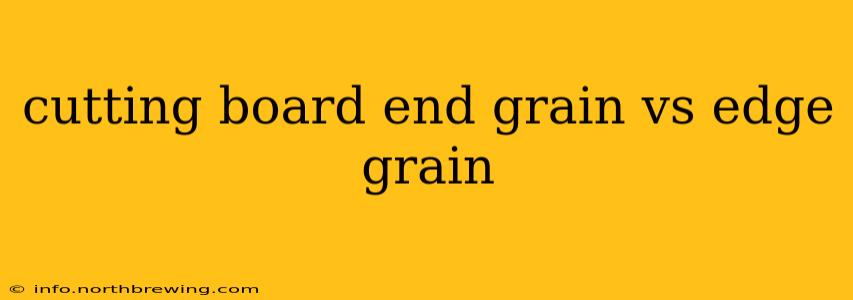Choosing the right cutting board can significantly impact your cooking experience and the longevity of your knives. Two popular types dominate the market: end-grain and edge-grain cutting boards. Understanding the key differences between them is crucial for making an informed decision. This guide will delve into the pros and cons of each, helping you determine which best suits your needs and budget.
What is an End-Grain Cutting Board?
End-grain cutting boards are made by arranging wood pieces so that the end grain (the cross-section of the tree) is exposed on the cutting surface. This creates a surface with numerous tiny, vertical wood fibers. Think of it like a forest of miniature trees standing upright.
Pros of End-Grain Cutting Boards:
- Superior Knife Protection: The vertical wood fibers act as tiny shock absorbers, significantly reducing knife blade damage and dulling. This makes them the preferred choice for professional chefs and serious home cooks.
- Self-Healing Properties: Minor cuts and scratches tend to close up naturally due to the wood fibers, extending the board's lifespan.
- More Comfortable to Use: The slightly yielding surface is generally more comfortable on the hands and wrists during prolonged use.
Cons of End-Grain Cutting Boards:
- More Expensive: Due to the labor-intensive construction process, end-grain cutting boards are typically more expensive than edge-grain boards.
- More Prone to Damage from Liquids: The porous nature of wood allows for more liquid absorption, requiring more careful drying and maintenance to prevent bacterial growth and warping.
- Heavier: The denser construction makes end-grain boards heavier than edge-grain counterparts.
What is an Edge-Grain Cutting Board?
In edge-grain cutting boards, the wood pieces are arranged so that the long, narrow side of the wood is exposed on the cutting surface. The wood fibers run parallel to the surface.
Pros of Edge-Grain Cutting Boards:
- More Affordable: They are generally less expensive to produce, making them a budget-friendly option.
- Less Porous (Generally): Compared to end-grain, edge-grain boards can absorb less liquid, reducing the risk of warping and bacterial growth.
- Lighter and Easier to Handle: Their lighter weight makes them easier to maneuver and store.
Cons of Edge-Grain Cutting Boards:
- More Knife Damage: The parallel wood fibers offer less protection to knife blades, leading to more frequent sharpening.
- Less Durable: They tend to show wear and tear more quickly than end-grain boards, often requiring replacement sooner.
- Less Comfortable: The harder, less yielding surface can be less comfortable for extended use.
Which Type of Cutting Board is Best for Me?
The ideal choice depends on your priorities:
- Prioritize knife protection and longevity? Choose end-grain.
- Need a budget-friendly option? Choose edge-grain.
- Value ease of handling and cleaning? Edge-grain might be preferable.
- Prefer a cutting board that's comfortable to use for long periods? End-grain is generally more comfortable.
How to Maintain Your Cutting Board (Both Types)?
Regardless of the type you choose, proper maintenance is essential for extending its lifespan and ensuring food safety:
- Clean immediately after use: Wash with warm, soapy water. Avoid soaking, as this can lead to warping.
- Dry thoroughly: Use a clean towel to dry the board completely. Allowing moisture to remain can encourage bacteria growth and damage the wood.
- Oil regularly: Apply a food-safe mineral oil to condition the wood and prevent cracking. Follow the manufacturer's recommendations for oiling frequency.
What type of wood is best for cutting boards?
The best wood for cutting boards depends on several factors, including hardness, density, and resistance to moisture. Hardwoods like maple, cherry, and walnut are popular choices because they are durable and resistant to wear. However, the type of wood is secondary to the grain orientation (end-grain vs. edge-grain) in terms of knife protection.
Are there other types of cutting boards besides end-grain and edge-grain?
Yes, there are other types of cutting boards, including side-grain, which is less common and generally less desirable than end-grain or edge-grain. There are also plastic cutting boards, which offer different advantages and disadvantages compared to wood.
By carefully considering the factors discussed above, you can choose the cutting board that best fits your cooking style, budget, and needs. Remember that a well-maintained cutting board, regardless of its grain orientation, will last for years, making it a worthwhile investment in your kitchen.
